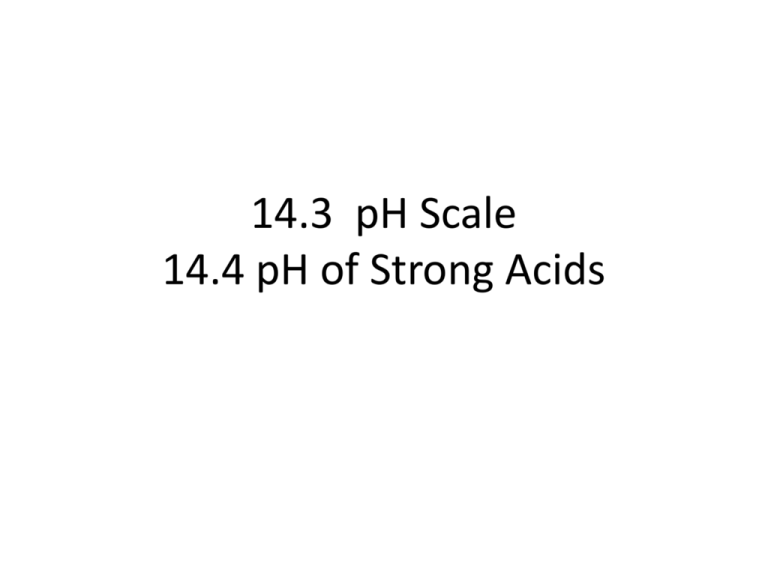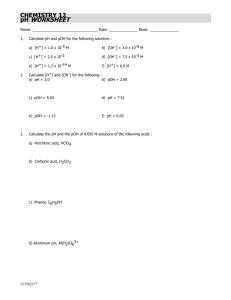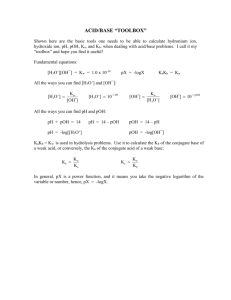
14.3 pH Scale
14.4 pH of Strong Acids
The pH Scale &
pH Values of
Some Common
Substances
Copyright © Cengage Learning. All rights reserved
2
pH Range
• pH = 7; neutral
• pH > 7; basic
– Higher the pH, more basic.
• pH < 7; acidic
– Lower the pH, more acidic.
Copyright © Cengage Learning. All rights reserved
3
14.3 – The pH Scale
• pH = –log[H+]
• pH changes by 1 for every power of 10 change in
[H+].
• pH is a quantitative description of solution acidity.
• pH decreases as [H+] increases.
• Significant figures:
– The number of decimal places in the log is equal
to the number of significant figures in the
original number.
– Example: If [H+] = 0.010 M or 1.0×10-2M
pH = 2.00
Two significant figures!
Copyright © Cengage Learning. All rights reserved
4
14.3 – Calculating pH
Calculate the pH for each of the following solutions.
a) 1.0 × 10–4 M H+
pH = -log(1.0 × 10–4) = 4.00
Is this answer reasonable?
Yes! Because an acid is present in a low
concentration –the pH is a little below 7
b) 0.0400 M H+
pH = -log(0.0400) = 1.398
Is this answer reasonable?
Yes! Because an acid is present in a higher
concentration –the pH is even lower
Copyright © Cengage Learning. All rights reserved
5
14.3 – Calculating concentration
from pH
The pH of a solution is 5.85. What is the [H+] for this
solution?
pH = –log[H+], so [H+] = the inverse log of –pH
[H+] = 10–pH
[H+] = 10–5.85 = 1.4 × 10–6 M
Is this answer reasonable?
Yes! The solution is acidic (pH below 7), but
not very acidic – it has a low [H+]
Copyright © Cengage Learning. All rights reserved
6
14.3 pH and pOH
• The Acid-Base calculation tool kit:
Kw = [H+][OH–] = 1×10-14
–log Kw = –log[H+] – log[OH–]
pKw = pH + pOH
14.00 = pH + pOH
Copyright © Cengage Learning. All rights reserved
7
14.3 – Calculating pOH
EXERCISE!
Calculate the pOH for each of the following solutions.
a) 1.0 × 10–4 M H+
pOH = 10.00 –two significant figures
Is this reasonable?
Yes! Because pH = 4, & pH + pOH = 14
b) 0.0400 M OH–
pOH = 1.398 –three significant figures
Is this reasonable?
Yes! [OH-] is fairly high = low pOH and high pH =
a basic solution is present
Copyright © Cengage Learning. All rights reserved
8
14.3 – Calculating concentration
from
pOH
EXERCISE!
The pH of a solution is 5.85. What is the [OH–] for this
solution?
[H+] = 10–5.85 = 1.4 × 10–6 M
[H+][OH–] = 1×10-14
(1.4 × 10–6 M)[OH–] = 1×10-14
[OH–] = 1×10-14 ÷ 1.4 × 10–6 M = 7.1 × 10–9 M
Or: 14 – pH = pOH; 14 - 5.85 = pOH = 8.15
[OH-] = 10–8.15 = 7.1 × 10–9 M
[OH–] = 7.1 × 10–9 M
Copyright © Cengage Learning. All rights reserved
9
Thinking About Acid–Base Problems
• What are the major species in solution?
• What is the dominant reaction that will take place?
– Is it an equilibrium reaction or a reaction that will
go essentially to completion?
– React all major species until you are left with an
equilibrium reaction.
• Solve for the pH if needed.
Copyright © Cengage Learning. All rights reserved
10
14.4 – Calculating pH of a Strong
CONCEPT CHECK!
Acid
What is the pH of an aqueous solution of 2.0 × 10–3 M
HCl.
What are the major species in solution?
H+, Cl–, H2O
HCl H+ + Cl–
Also: H O H+ + OH–
2
pH will be affected by [H+]
Main source of [H+]?
What is the pH?
pH = -log(2.0 × 10–3 ) = 2.70
YES! Because a strong acid is present in a
pretty high concentration!
Copyright © Cengage Learning. All rights reserved
11
Reasonable answer?
14.4 – Calculating pH of a Strong
CONCEPT CHECK!
Acid
Calculate the pH of a 1.5 × 10–11 M solution of
HCl.
What are the major species in solution?
H+, Cl–, H2O
HCl H+ + Cl–
Also: H O H+ + OH–
2
Main source of [H+]?
What is the pH?
–7 ) = 7.00
pH = -log(1.0YES!
× A10tiny
bit of a strong acid won’t
Reasonable answer?
Copyright © Cengage Learning. All rights reserved
change the pH!
12
CONCEPT CHECK!
Calculate the pH of a 1.5 × 10–2 M solution of
HNO3.
Copyright © Cengage Learning. All rights reserved
14
Let’s Think About It…
• When HNO3 is added to water, a reaction takes
place immediately:
HNO3 + H2O H3O+ + NO3–
Copyright © Cengage Learning. All rights reserved
15
Let’s Think About It…
• Why is this reaction not likely?
NO3–(aq) + H2O(l)
Copyright © Cengage Learning. All rights reserved
HNO3(aq) + OH–(aq)
16
Let’s Think About It…
• What reaction controls the pH?
• H2O(l) + H2O(l)
H3O+(aq) + OH–(aq)
• In aqueous solutions, this reaction is always taking
place.
• But is water the major contributor of H+ (H3O+)?
pH = 1.82
Copyright © Cengage Learning. All rights reserved
17






